MARKETING
Level up your mobile app experience

How recently have you reached for your phone to shop and research? For most of us, including myself, it’s likely we’ve done that just today. Factors such as the global pandemic, a generational shift to the younger workforce and rising B2C ecommerce expectations have accelerated the rate at which B2B organizations are conducting business online. The digitally native generations now control a majority of spending and ordering dollars, so B2B organizations need to adjust to meet them halfway. With younger generations taking in the forefront, mobile experiences are now expected at the same level as having a commerce-enabled website.
Leveraging your mobile app
As you consider your customer buying journeys, mobile will be a touchpoint at least once along the way. The ability to provide a frictionless experience across all digital channels is a key element in a successful customer experience. It’s common for customers to research from their desktop computers and then transition to using mobile – and they expect to pick up right where they left off.
The number of channels that customers are using to interact is growing as well. Optimizely’s Configured Commerce mobile app made an appearance in 2019 and the expansion continues into 2021 and beyond. It’s clear the B2B market has rising expectations for easy workflows and ordering.

(McKinsey)
If you’re looking for more data to support this, it’s predicted that retail sales via smartphones is expected to grow by 19.9% yearly until 2024. Buyers who purchase from a smartphone will represent 84% of the U.S. market by then as well. (Forrester) If we look closer at the average order value from mobile from 2020 to 2021, there was a $28.17 increase. (Statistica)

Mobile SDK for Configured Commerce
To help customers expand their mobile reach, Optimizely has just released a Mobile SDK for our Configured Commerce Cloud. The Configured Commerce Mobile SDK will allow customers to unlock the full potential of a native mobile app leveraging the base functionality of the Configured Commerce platform and expand it to include any customizations that may be in place. Personalize the experience, create one or many mobile apps – the possibilities are limitless!
Buyers today have an expectation of a seamless, frictionless, omni-channel experience. The ability to personalize and provide the same level of experience on a desktop and a native mobile app is table stakes for future success. Optimizely’s Mobile SDK will allow customers to do just that. Customers and partners can now leverage the Mobile SDK to align features and functionality from the website with the mobile app.
Mobile is a necessary piece in your digital strategy, and Optimizely is providing more ways to build mobile capabilities. Optimizely will continue to release mobile innovations like Vendor Managed Inventory (VMI), visual search and location-based services. There’s so much more to come.
If you are interested in learning more about the Configured Commerce Mobile SDK, check out our documentation. And we encourage you to connect with your implementation partner to discuss the best mobile strategy approach for you!
MARKETING
Will Google Buy HubSpot? | Content Marketing Institute

Google + HubSpot. Is it a thing?
This week, a flurry of news came down about Google’s consideration of purchasing HubSpot.
The prospect dismayed some. It delighted others.
But is it likely? Is it even possible? What would it mean for marketers? What does the consideration even mean for marketers?
Well, we asked CMI’s chief strategy advisor, Robert Rose, for his take. Watch this video or read on:
Why Alphabet may want HubSpot
Alphabet, the parent company of Google, apparently is contemplating the acquisition of inbound marketing giant HubSpot.
The potential price could be in the range of $30 billion to $40 billion. That would make Alphabet’s largest acquisition by far. The current deal holding that title happened in 2011 when it acquired Motorola Mobility for more than $12 billion. It later sold it to Lenovo for less than $3 billion.
If the HubSpot deal happens, it would not be in character with what the classic evil villain has been doing for the past 20 years.
At first glance, you might think the deal would make no sense. Why would Google want to spend three times as much as it’s ever spent to get into the inbound marketing — the CRM and marketing automation business?
At a second glance, it makes a ton of sense.
I don’t know if you’ve noticed, but I and others at CMI spend a lot of time discussing privacy, owned media, and the deprecation of the third-party cookie. I just talked about it two weeks ago. It’s really happening.
All that oxygen being sucked out of the ad tech space presents a compelling case that Alphabet should diversify from third-party data and classic surveillance-based marketing.
Yes, this potential acquisition is about data. HubSpot would give Alphabet the keys to the kingdom of 205,000 business customers — and their customers’ data that almost certainly numbers in the tens of millions. Alphabet would also gain access to the content, marketing, and sales information those customers consumed.
Conversely, the deal would provide an immediate tip of the spear for HubSpot clients to create more targeted programs in the Alphabet ecosystem and upload their data to drive even more personalized experiences on their own properties and connect them to the Google Workspace infrastructure.
When you add in the idea of Gemini, you can start to see how Google might monetize its generative AI tool beyond figuring out how to use it on ads on search results pages.
What acquisition could mean for HubSpot customers
I may be stretching here but imagine this world. As a Hubspoogle customer, you can access an interface that prioritizes your owned media data (e.g., your website, your e-commerce catalog, blog) when Google’s Gemini answers a question).
Recent reports also say Google may put up a paywall around the new premium features of its artificial intelligence-powered Search Generative Experience. Imagine this as the new gating for marketing. In other words, users can subscribe to Google’s AI for free, but Hubspoogle customers can access that data and use it to create targeted offers.
The acquisition of HubSpot would immediately make Google Workspace a more robust competitor to Microsoft 365 Office for small- and medium-sized businesses as they would receive the ADDED capability of inbound marketing.
But in the world of rented land where Google is the landlord, the government will take notice of the acquisition. But — and it’s a big but, I cannot lie (yes, I just did that). The big but is whether this acquisition dance can happen without going afoul of regulatory issues.
Some analysts say it should be no problem. Others say, “Yeah, it wouldn’t go.” Either way, would anybody touch it in an election year? That’s a whole other story.
What marketers should realize
So, what’s my takeaway?
It’s a remote chance that Google will jump on this hard, but stranger things have happened. It would be an exciting disruption in the market.
The sure bet is this. The acquisition conversation — as if you needed more data points — says getting good at owned media to attract and build audiences and using that first-party data to provide better communication and collaboration with your customers are a must.
It’s just a matter of time until Google makes a move. They might just be testing the waters now, but they will move here. But no matter what they do, if you have your customer data house in order, you’ll be primed for success.
HANDPICKED RELATED CONTENT:
Cover image by Joseph Kalinowski/Content Marketing Institute
MARKETING
5 Psychological Tactics to Write Better Emails

Welcome to Creator Columns, where we bring expert HubSpot Creator voices to the Blogs that inspire and help you grow better.
I’ve tested 100s of psychological tactics on my email subscribers. In this blog, I reveal the five tactics that actually work.
You’ll learn about the email tactic that got one marketer a job at the White House.
You’ll learn how I doubled my 5 star reviews with one email, and why one strange email from Barack Obama broke all records for donations.
5 Psychological Tactics to Write Better Emails
Imagine writing an email that’s so effective it lands you a job at the White House.
Well, that’s what happened to Maya Shankar, a PhD cognitive neuroscientist. In 2014, the Department of Veterans Affairs asked her to help increase signups in their veteran benefit scheme.
Maya had a plan. She was well aware of a cognitive bias that affects us all—the endowment effect. This bias suggests that people value items higher if they own them. So, she changed the subject line in the Veterans’ enrollment email.
Previously it read:
- Veterans, you’re eligible for the benefit program. Sign up today.
She tweaked one word, changing it to:
- Veterans, you’ve earned the benefits program. Sign up today.
This tiny tweak had a big impact. The amount of veterans enrolling in the program went up by 9%. And Maya landed a job working at the White House
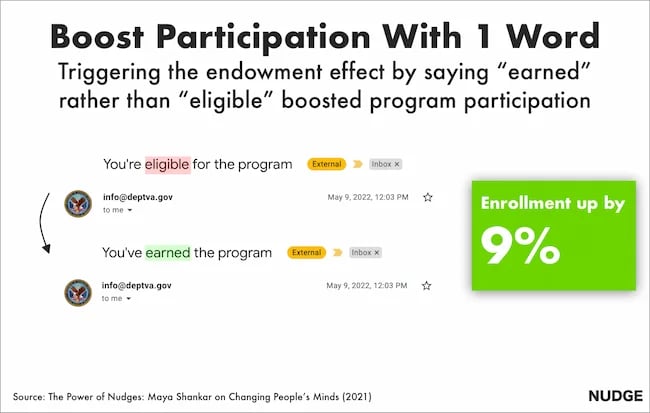
Inspired by these psychological tweaks to emails, I started to run my own tests.
Alongside my podcast Nudge, I’ve run 100s of email tests on my 1,000s of newsletter subscribers.
Here are the five best tactics I’ve uncovered.
1. Show readers what they’re missing.
Nobel prize winning behavioral scientists Daniel Kahneman and Amos Tversky uncovered a principle called loss aversion.
Loss aversion means that losses feel more painful than equivalent gains. In real-world terms, losing $10 feels worse than how gaining $10 feels good. And I wondered if this simple nudge could help increase the number of my podcast listeners.
For my test, I tweaked the subject line of the email announcing an episode. The control read:
“Listen to this one”
In the loss aversion variant it read:
“Don’t miss this one”
It is very subtle loss aversion. Rather than asking someone to listen, I’m saying they shouldn’t miss out. And it worked. It increased the open rate by 13.3% and the click rate by 12.5%. Plus, it was a small change that cost me nothing at all.
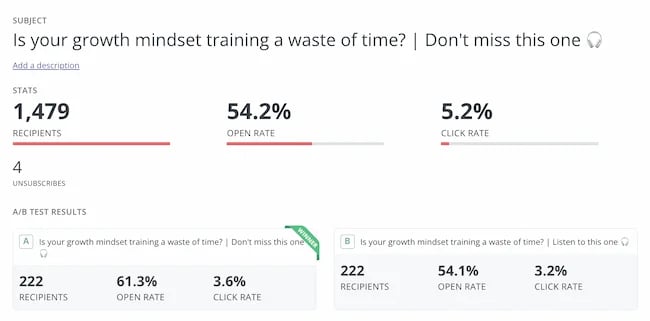
2. People follow the crowd.
In general, humans like to follow the masses. When picking a dish, we’ll often opt for the most popular. When choosing a movie to watch, we tend to pick the box office hit. It’s a well-known psychological bias called social proof.
I’ve always wondered if it works for emails. So, I set up an A/B experiment with two subject lines. Both promoted my show, but one contained social proof.
The control read: New Nudge: Why Brands Should Flaunt Their Flaws
The social proof variant read: New Nudge: Why Brands Should Flaunt Their Flaws (100,000 Downloads)
I hoped that by highlighting the episode’s high number of downloads, I’d encourage more people to listen. Fortunately, it worked.
The open rate went from 22% to 28% for the social proof version, and the click rate, (the number of people actually listening to the episode), doubled.
3. Praise loyal subscribers.
The consistency principle suggests that people are likely to stick to behaviours they’ve previously taken. A retired taxi driver won’t swap his car for a bike. A hairdresser won’t change to a cheap shampoo. We like to stay consistent with our past behaviors.
I decided to test this in an email.
For my test, I attempted to encourage my subscribers to leave a review for my podcast. I sent emails to 400 subscribers who had been following the show for a year.
The control read: “Could you leave a review for Nudge?”
The consistency variant read: “You’ve been following Nudge for 12 months, could you leave a review?”
My hypothesis was simple. If I remind people that they’ve consistently supported the show they’ll be more likely to leave a review.
It worked.
The open rate on the consistency version of the email was 7% higher.
But more importantly, the click rate, (the number of people who actually left a review), was almost 2x higher for the consistency version. Merely telling people they’d been a fan for a while doubled my reviews.
4. Showcase scarcity.
We prefer scarce resources. Taylor Swift gigs sell out in seconds not just because she’s popular, but because her tickets are hard to come by.
Swifties aren’t the first to experience this. Back in 1975, three researchers proved how powerful scarcity is. For the study, the researchers occupied a cafe. On alternating weeks they’d make one small change in the cafe.
On some weeks they’d ensure the cookie jar was full.
On other weeks they’d ensure the cookie jar only contained two cookies (never more or less).
In other words, sometimes the cookies looked abundantly available. Sometimes they looked like they were almost out.
This changed behaviour. Customers who saw the two cookie jar bought 43% more cookies than those who saw the full jar.
It sounds too good to be true, so I tested it for myself.
I sent an email to 260 subscribers offering free access to my Science of Marketing course for one day only.
In the control, the subject line read: “Free access to the Science of Marketing course”
For the scarcity variant it read: “Only Today: Get free access to the Science of Marketing Course | Only one enrol per person.”
130 people received the first email, 130 received the second. And the result was almost as good as the cookie finding. The scarcity version had a 15.1% higher open rate.

5. Spark curiosity.
All of the email tips I’ve shared have only been tested on my relatively small audience. So, I thought I’d end with a tip that was tested on the masses.
Back in 2012, Barack Obama and his campaign team sent hundreds of emails to raise funds for his campaign.
Of the $690 million he raised, most came from direct email appeals. But there was one email, according to ABC news, that was far more effective than the rest. And it was an odd one.
The email that drew in the most cash, had a strange subject line. It simply said “Hey.”
The actual email asked the reader to donate, sharing all the expected reasons, but the subject line was different.
It sparked curiosity, it got people wondering, is Obama saying Hey just to me?
Readers were curious and couldn’t help but open the email. According to ABC it was “the most effective pitch of all.”
Because more people opened, it raised more money than any other email. The bias Obama used here is the curiosity gap. We’re more likely to act on something when our curiosity is piqued.
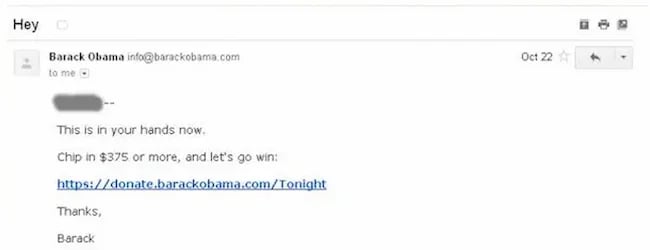
Loss aversion, social proof, consistency, scarcity and curiosity—all these nudges have helped me improve my emails. And I reckon they’ll work for you.
It’s not guaranteed of course. Many might fail. But running some simple a/b tests for your emails is cost free, so why not try it out?
This blog is part of Phill Agnew’s Marketing Cheat Sheet series where he reveals the scientifically proven tips to help you improve your marketing. To learn more, listen to his podcast Nudge, a proud member of the Hubspot Podcast Network.
MARKETING
The power of program management in martech

As a supporter of the program perspective for initiatives, I recognize the value of managing related projects, products and activities as a unified entity.
While one-off projects have their place, they often involve numerous moving parts and in my experience, using a project-based approach can lead to crucial elements being overlooked. This is particularly true when building a martech stack or developing content, for example, where a program-based approach can ensure that all aspects are considered and properly integrated.
For many CMOs and marketing organizations, programs are becoming powerful tools for aligning diverse initiatives and driving strategic objectives. Let’s explore the essential role of programs in product management, project management and marketing operations, bridging technical details with business priorities.
Programs in product management
Product management is a fascinating domain where programs operate as a strategic framework, coordinating related products or product lines to meet specific business objectives.
Product managers are responsible for defining a product or product line’s strategy, roadmap and features. They work closely with program managers, who ensure alignment with market demands, customer needs and the company’s overall vision by managing offerings at a program level.
Program managers optimize the product portfolio, make strategic decisions about resource allocation and ensure that each product contributes to the program’s goals. One key aspect of program management in product management is identifying synergies between products.
Program managers can drive innovation and efficiency across the portfolio by leveraging shared technologies, customer insights, or market trends. This approach enables organizations to respond quickly to changing market conditions, seize emerging opportunities and maintain a competitive advantage. Product managers, in turn, use these insights to shape the direction of individual products.
Moreover, programs in product management facilitate cross-functional collaboration and knowledge sharing. Program managers foster a holistic understanding of customer needs and market dynamics by bringing together teams from various departments, such as engineering, marketing and sales.
Product managers also play a crucial role in this collaborative approach, ensuring that all stakeholders work towards common goals, ultimately leading to more successful product launches and enhanced customer satisfaction.
Dig deeper: Understanding different product roles in marketing technology acquisition
Programs in project management
In project management, programs provide a structured approach for managing related projects as a unified entity, supporting broader strategic objectives. Project managers are responsible for planning, executing and closing individual projects within a program. They focus on specific deliverables, timelines and budgets.
On the other hand, program managers oversee these projects’ coordination, dependencies and outcomes, ensuring they collectively deliver the desired benefits and align with the organization’s strategic goals.
A typical example of a program in project management is a martech stack optimization initiative. Such a program may involve integrating marketing technology tools and platforms, implementing customer data management systems and training employees on the updated technologies. Project managers would be responsible for the day-to-day management of each project.
In contrast, the program manager ensures a cohesive approach, minimizes disruptions and realizes the full potential of the martech investments to improve marketing efficiency, personalization and ROI.
The benefits of program management in project management are numerous. Program managers help organizations prioritize initiatives that deliver the greatest value by aligning projects with strategic objectives. They also identify and mitigate risks that span multiple projects, ensuring that issues in one area don’t derail the entire program. Project managers, in turn, benefit from this oversight and guidance, as they can focus on successfully executing their projects.
Additionally, program management enables efficient resource allocation, as skills and expertise can be shared across projects, reducing duplication of effort and maximizing value. Project managers can leverage these resources and collaborate with other project teams to achieve their objectives more effectively.
Dig deeper: Combining martech projects: 5 questions to ask
Programs in marketing operations
In marketing operations, programs play a vital role in integrating and managing various marketing activities to achieve overarching goals. Marketing programs encompass multiple initiatives, such as advertising, content marketing, social media and event planning. Organizations ensure consistent messaging, strategic alignment, and measurable results by managing these activities as a cohesive program.
In marketing operations, various roles, such as MOps managers, campaign managers, content managers, digital marketing managers and analytics managers, collaborate to develop and execute comprehensive marketing plans that support the organization’s business objectives.
These professionals work closely with cross-functional teams, including creative, analytics and sales, to ensure that all marketing efforts are coordinated and optimized for maximum impact. This involves setting clear goals, defining key performance indicators (KPIs) and continuously monitoring and adjusting strategies based on data-driven insights.
One of the primary benefits of a programmatic approach in marketing operations is maintaining a consistent brand voice and message across all channels. By establishing guidelines and standards for content creation, visual design and customer interactions, marketing teams ensure that the brand’s identity remains cohesive and recognizable. This consistency builds customer trust, reinforces brand loyalty and drives business growth.
Programs in marketing operations enable organizations to take a holistic approach to customer engagement. By analyzing customer data and feedback across various touchpoints, marketing professionals can identify opportunities for improvement and develop targeted strategies to enhance the customer experience. This customer-centric approach leads to increased satisfaction, higher retention rates and more effective marketing investments.
Dig deeper: Mastering the art of goal setting in marketing operations
Embracing the power of programs for long-term success
We’ve explored how programs enable marketing organizations to drive strategic success and create lasting impact by aligning diverse initiatives across product management, project management and marketing operations.
- Product management programs facilitate cross-functional collaboration and ensure alignment with market demands.
- In project management, they provide a structured approach for managing related projects and mitigating risks.
- In marketing operations, programs enable consistent messaging and a customer-centric approach to engagement.
Program managers play a vital role in maintaining strategic alignment, continuously assessing progress and adapting to changes in the business environment. Keeping programs aligned with long-term objectives maximizes ROI and drives sustainable growth.
Organizations that invest in developing strong program management capabilities will be better positioned to optimize resources, foster innovation and achieve their long-term goals.
As a CMO or marketing leader, it is important to recognize the strategic value of programs and champion their adoption across your organization. By aligning efforts across various domains, you can unlock the full potential of your initiatives and drive meaningful results. Try it, you’ll like it.
Fuel for your marketing strategy.
Opinions expressed in this article are those of the guest author and not necessarily MarTech. Staff authors are listed here.
-

 PPC7 days ago
PPC7 days agoCompetitor Monitoring: 7 ways to keep watch on the competition
-

 WORDPRESS6 days ago
WORDPRESS6 days agoTurkish startup ikas attracts $20M for its e-commerce platform designed for small businesses
-

 PPC7 days ago
PPC7 days ago31 Ready-to-Go Mother’s Day Messages for Social Media, Email, & More
-

 PPC6 days ago
PPC6 days agoA History of Google AdWords and Google Ads: Revolutionizing Digital Advertising & Marketing Since 2000
-

 SEARCHENGINES7 days ago
SEARCHENGINES7 days agoMore Google March 2024 Core Update Ranking Volatility
-

 MARKETING5 days ago
MARKETING5 days agoRoundel Media Studio: What to Expect From Target’s New Self-Service Platform
-
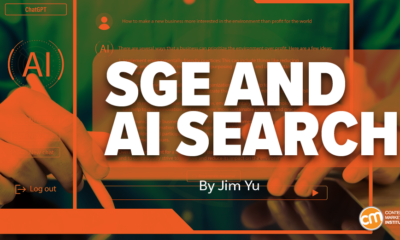
 MARKETING7 days ago
MARKETING7 days agoHow To Adapt Your SEO and Content Strategies for SGE and AI Experiences
-

 SEO5 days ago
SEO5 days agoGoogle Limits News Links In California Over Proposed ‘Link Tax’ Law

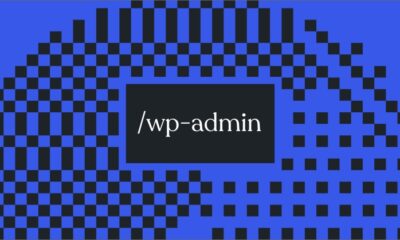

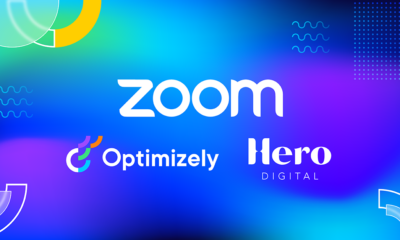





![The Current State of Google's Search Generative Experience [What It Means for SEO in 2024] The Current State of Google's Search Generative Experience [What It Means for SEO in 2024]](https://articles.entireweb.com/wp-content/uploads/2024/02/The-Current-State-of-Googles-Search-Generative-Experience-What-It-400x240.jpg)
![The Current State of Google's Search Generative Experience [What It Means for SEO in 2024] The Current State of Google's Search Generative Experience [What It Means for SEO in 2024]](https://articles.entireweb.com/wp-content/uploads/2024/02/The-Current-State-of-Googles-Search-Generative-Experience-What-It-80x80.jpg)
![5 Psychological Tactics to Write Better Emails → Download Now: The Beginner's Guide to Email Marketing [Free Ebook]](https://articles.entireweb.com/wp-content/uploads/2023/02/11-Free-Email-Hacks-to-Step-Up-Your-Productivity.png)
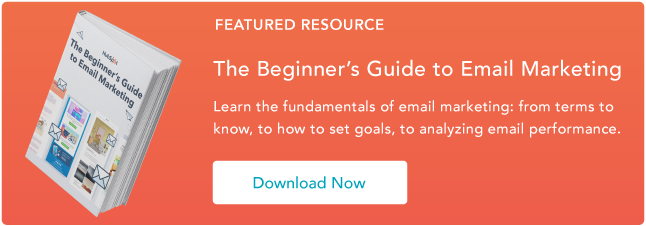


You must be logged in to post a comment Login